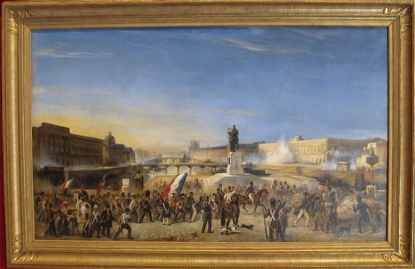So, we all have heard about the French Revolution, the names Robespierre, Napoleon and Marie Antoinette. But beyond the names, what actually happened? How do they all fit together? Well, in Paris, there is an AWESOME museum that allows you to see (through the paintings of the time) what happened. For some reason, I was totally into history during my visit to Paris and spent a great morning at the Musee Carnevalet and later at Invalides with the WWII exhibit. I have to give a shout out to the Rick Steves commentary in his guide book, it was great and I learned much from it. In fact, I have to attribute much of the commentary of this post to his book.
Louis the XIVth, the Sun King was NOT a player in the French Revolution.
Louis XVIth in this allegorical painting is the king (being tempted by black tyranny to the right, along with the clergy and nobles rule France. However, it is the people who rise up to demand a voice in their government.
So the people split and form their own National Assembly here shown in the "Oath jeu de paume"
We've all heard of Bastille day, June 14th, 1789. On this day, the people of Paris seized weaponry and stormed the Bastille where the gunpowder was stored, which was also the prison.
A model of the Bastille, which no longer stands today.
Here in "La Fete de la federation", on the one year anniversary of Bastille Day, it is the celebration of Liberty! Equality! Fraternity!
More celebration!
The Declaration of the Rights of Man and the Citizen. To me it's strange to think that this was essentially concurrent with the battle for independence in the United States. For some reason I never think of these events in the same time frame.
Recognize this guys name....Guillotin? When the Assembly abolished torture, Guillotin's "razor" was introduced as the more "compassionate" execution device.
Louis the XVIth didn't understand the unhappiness and discontent that lead to the events of 1789. As the Assembly was making society more democratic (i.e. making the king irrelevant), Louis XVIth let it all happen without much resistance.
1792, the Royal Family, Louis XVI, Marie Antoinette (his wife) and their son were imprisoned separately. Here is the split of the family in "Les adieux des Louis XVI a se famille"
January 21, 1793 Louis XVIth is executed. By guillotin, of course!
October 16, 1793, Marie Antoinette herself was executed.

By 1793, the French democracy was driving by strong personalities such as Georges Danton. But there were those, who might be called a bit McCarthy-like, who saw enemies (those who wanted to reinstate the monarchy) everywhere and had them executed.
Jean-Paul Marat was another proponent of democracy for the people. He became a rallying symbol of the movement when he was killed by a woman who was bent of "saving France."
And we come to Maximilien de Robespierre, the Master of the "Reign of Terror". By 1794 he was having 30 people executed a day for being enemies of the revolution. Robespierre even had Danton executed. In July 1794, Robespierre himself was executed.
By 1799, Napoleon Bonaparte returned to Paris a hero of many foreign battles and established himself as the "first consul" of France.
Napoleon in military dress. In 1812, Napoleon invaded Russia (never a good idea) which became a losing battle and in 1815, he was defeated by other European countries at Waterloo. He was exiled. Between 1815-1830, the monarchy was restored.
1830, revolution in the streets again.
Louis-Philippe was installed as the constitutional monarch.
Celebrating at the Arc de Triomphe. But in 1848, Parisians took to the street again and the result was The Second Republic, power in the hands of the people, again.
In 1848, Napoleon III (nephew of the exiled Napoleon) was "elected" as the "Emperor" combining democracy with monarchy....again.
Although Napoleon III promoted economic liberalism, he also pursued wars. But in 1870, Paris was surrounded by foreign armies and in this painting we see Parisians being notified that Paris surrendered.
Without an emperor, and sending up a leading minister in a balloon to rally the countryside, the French were overwhelmed and in time a Third Republic was established.
There was more the museum, but I ran out of time before it closed for lunch. I enjoyed myself, and more than anything, it gives meaning to the words I know in my favorite national anthem, La Marsailles!

There was more the museum, but I ran out of time before it closed for lunch. I enjoyed myself, and more than anything, it gives meaning to the words I know in my favorite national anthem, La Marsailles!
























No comments:
Post a Comment